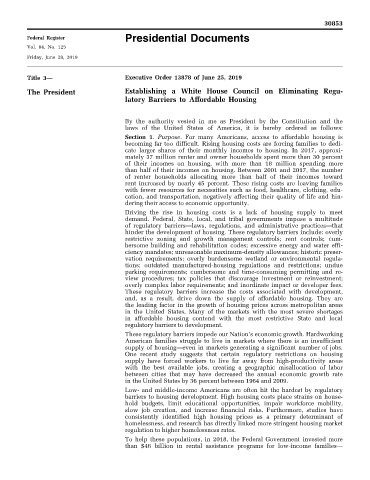Page 884 - Trump Executive Orders 2017-2021
P. 884
30853
Federal Register Presidential Documents
Vol. 84, No. 125
Friday, June 28, 2019
Title 3— Executive Order 13878 of June 25, 2019
The President Establishing a White House Council on Eliminating Regu-
latory Barriers to Affordable Housing
By the authority vested in me as President by the Constitution and the
laws of the United States of America, it is hereby ordered as follows:
Section 1. Purpose. For many Americans, access to affordable housing is
becoming far too difficult. Rising housing costs are forcing families to dedi-
cate larger shares of their monthly incomes to housing. In 2017, approxi-
mately 37 million renter and owner households spent more than 30 percent
of their incomes on housing, with more than 18 million spending more
than half of their incomes on housing. Between 2001 and 2017, the number
of renter households allocating more than half of their incomes toward
rent increased by nearly 45 percent. These rising costs are leaving families
with fewer resources for necessities such as food, healthcare, clothing, edu-
cation, and transportation, negatively affecting their quality of life and hin-
dering their access to economic opportunity.
Driving the rise in housing costs is a lack of housing supply to meet
demand. Federal, State, local, and tribal governments impose a multitude
of regulatory barriers—laws, regulations, and administrative practices—that
hinder the development of housing. These regulatory barriers include: overly
restrictive zoning and growth management controls; rent controls; cum-
bersome building and rehabilitation codes; excessive energy and water effi-
ciency mandates; unreasonable maximum-density allowances; historic preser-
vation requirements; overly burdensome wetland or environmental regula-
tions; outdated manufactured-housing regulations and restrictions; undue
parking requirements; cumbersome and time-consuming permitting and re-
view procedures; tax policies that discourage investment or reinvestment;
overly complex labor requirements; and inordinate impact or developer fees.
These regulatory barriers increase the costs associated with development,
and, as a result, drive down the supply of affordable housing. They are
the leading factor in the growth of housing prices across metropolitan areas
in the United States. Many of the markets with the most severe shortages
in affordable housing contend with the most restrictive State and local
regulatory barriers to development.
These regulatory barriers impede our Nation’s economic growth. Hardworking
American families struggle to live in markets where there is an insufficient
supply of housing—even in markets generating a significant number of jobs.
One recent study suggests that certain regulatory restrictions on housing
supply have forced workers to live far away from high-productivity areas
with the best available jobs, creating a geographic misallocation of labor
between cities that may have decreased the annual economic growth rate
in the United States by 36 percent between 1964 and 2009.
Low- and middle-income Americans are often hit the hardest by regulatory
barriers to housing development. High housing costs place strains on house-
khammond on DSKBBV9HB2PROD with PRES DOC VerDate Sep<11>2014 16:23 Jun 27, 2019 Jkt 247001 PO 00000 Frm 00001 Fmt 4705 Sfmt 4790 E:\FR\FM\28JNE0.SGM 28JNE0
hold budgets, limit educational opportunities, impair workforce mobility,
slow job creation, and increase financial risks. Furthermore, studies have
consistently identified high housing prices as a primary determinant of
homelessness, and research has directly linked more stringent housing market
regulation to higher homelessness rates.
To help these populations, in 2018, the Federal Government invested more
than $46 billion in rental assistance programs for low-income families—

